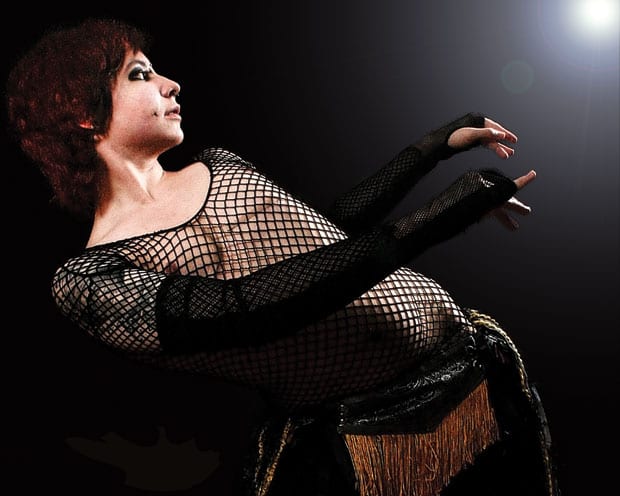Trans man Draconis von Trapp explains transitioning … to belly dancing

SHAKE AND SHIMMY | Von Trapp did not allow expectations of gender to interfere with his desire to
pursue belly dancing. (Photo courtesy Tammye Nash)
You might think there is no common ground between the transgender and Middle Eastern dance communities. But actually, they do have two things in common: Both are slowly gaining more mainstream popularity and acceptance (though most people get tongue-tied if you bring either up in casual conversation); and both are huge markers of my everyday life.
 I started feeling the first inklings of gender variance when I was in third grade and cut all my hair off. I distinctly remember younger kids asking, as unapologetically and bluntly as young kids are apt to, whether I was a boy or a girl. Of course, I hadn’t given it much thought — I just didn’t like brushing my hair — but it would be a catalyst for my journey down the gender spectrum.
I started feeling the first inklings of gender variance when I was in third grade and cut all my hair off. I distinctly remember younger kids asking, as unapologetically and bluntly as young kids are apt to, whether I was a boy or a girl. Of course, I hadn’t given it much thought — I just didn’t like brushing my hair — but it would be a catalyst for my journey down the gender spectrum.
Throughout middle and high schools, I couldn’t shake this “not quite male, not quite female” feeling, even though I was very clearly a biological girl. At 16, I confused not only myself, but all those with whom I had confided in about my gender issues, by joining a weekly belly dancing class at the Isis Studio of Performing Arts in Bedford. My interest in belly dance, in their eyes, conflicted with my “gender variance.” Undeterred, I pursued it.
Belly dance styles trace their origins to Turkey, Lebanon, Egypt, even North America. While the art is performed most commonly by women — dancers at restaurants, cabarets and the acclaimed dance company the Belly Dance Superstars are all dominated by women — male dancers can also be prominent practitioners.
I entered the intermediate class six months later, and my teacher started taking note of my ability to absorb techniques and choreography quickly. It seemed I had finally found my niche, something I was naturally good at … and I got along with all my dance sisters.
Even though I enjoyed every second of belly dancing and my newfound dance family, I never felt completely comfortable performing. I knew my technical skill and fluidity were there, but I never felt genuine onstage.
One year later, I started hormone therapy and was declared the new leader of the junior dance team at my studio. When I came out to everyone, I was met with overwhelming acceptance and a promise from Isis that I would still be able to dance with her studio … I’d just have to dress a little differently.
Six months after starting testosterone (and spending inappropriate amounts of money on male dance costuming), I won my first amateur competition at Yaa Halla, Y’all 2011, cited as a “Rising Star.” This past April, I swept yet another amateur competition at the Shimmy Showdown, winning first place and crowd favorite.
One month later, I had top surgery, masculinizing my chest and giving me the freedom to finally dance shirtless. By this time I had met many male belly dancers, proving to myself and those who questioned me that you didn’t have to identify as female to shimmy.
Yaa Halla, in its 12th year, attracts performers from all over the world to compete for prestigious titles and take workshops from true masters. I’ll compete in a duet category with Ayanna as Obsidian Mystique, a fusion of classic belly dance with a dark twist.
In just four years, I have gone from a gender-confused teenager to an award-winning trans belly dancer … give or take a few meltdowns. Now I’m more comfortable and confident than ever on and off stage. I’ve gained a small following on Facebook and YouTube, and I now teach a monthly workshop at my studio.
Of course, I still raise a few eyebrows.
This article appeared in the Dallas Voice print edition August 10, 2012.















